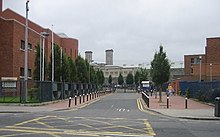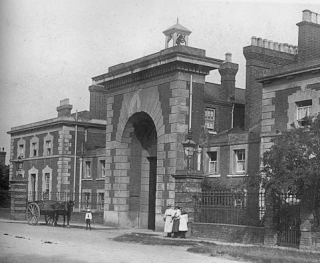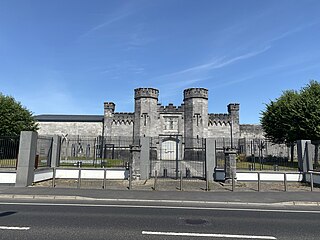
Prisons in Ireland are one of the main forms of punishment, rehabilitation, or both for the commission of an indictable offense and other offenses.

Prisons in Ireland are one of the main forms of punishment, rehabilitation, or both for the commission of an indictable offense and other offenses.
In 1925, shortly after the establishment of the Irish Free State, Minister for Justice, Kevin O'Higgins, introduced legislation repealing the existing ability of grand juries to appoint visiting committees to prisons within the State. Instead, the authority to appoint the members of prison visiting committees was vested solely in the person of the Minister. [1] [2] Similarly, the management of the prison system within the Irish Free State passed to the control of the Minister with the dissolution by statutory instrument of the General Prisons Board for Ireland (the G.P.B.) in 1928. [3] The G.P.B. had been an all-Ireland body. Thus, by this date, both the responsibility and control over the management and oversight of the prison service within the Irish Free State was held within the Minister's department. [4]
This situation remained unchanged until 1999 when the Minister for Justice, Equality and Law Reform, John O'Donoghue, established the Irish Prison Service to which was delegated the task of managing the day-to-day running of the prison system. [5] Simultaneously in 1999, a Prisons Authority Interim Board was established and its members were appointed by the Minister in 2000. The purpose of this board was to advise the director general and directors of the Irish Prison Service on the management of the penal system. [6] In 2002 the retired High Court Judge, Dermot Kinlen, was appointed the state's first Inspector of Irish Prisons. [7] However, none of these new bodies was ever established on a statutory basis despite indications to the contrary. Indeed, as recently as January 2011, Dermot Ahern informed the Dáil (Parliament) that:
I have no immediate plans to introduce legislation to place the Irish Prison Service or the Prisons Authority Interim Board on a statutory basis [8]
In 2009, the Irish Prison Service had an annual budget of €379.319 million and it had a staff of 3,568 people. [9]
Ireland is a member of the European Union and the EuroPris system. [10] Being a member of this system requires abolition of the death penalty and humane prison conditions. The goal of the Europris system is to ensure cooperation between European prison systems which aims to improve the lives of prisoner and their families, growing public safety and security, and reducing the re-offending rate.
The Irish prison system attempts to educate inmates and give them opportunities to avoid recidivism. The system provides multiple forms of education including vocational, life skills, basic education, healthy living, and technology education. The system also provides methamphetamine addiction treatment facilities that covers at least 80% of the Irish prison population. They also ready the inmates for reintegration and resettlement back into society and provide mental health and health services for the inmates. [11]
As of February 2021, the prison population in Ireland was 3,729. [12] In December 2020, the incarceration rate was approximately 73 per 100,000 inhabitants. [12]
The proportions in the prison population are; 17.6% are pre-trial and remand prisoners, 4.2% are females, 1.0% are under the age of 18, and 13.3% of the prisoners are foreign. The maximum number of prisoners the system can handle is 4,273; the prisons in Ireland are 87.5% full. For 2017, the rates in pre-trial and female prisons both went up, the pre-trial prisoners went up to a rate of 17.6% and the female rate went up to 4.2%. The previous rates for females, 3.4% in 2015 and pre-trial prisoners was 14.6% in 2015. The remand and pre-trial rate increased by 3% and the female rate increased by 0.8%. Since 2000, the lowest population the system has had is 2,948 which was in 2000, and the highest rate was 4,318 in 2012. [13]
There are 12 prisons in Ireland with a total bed capacity of 4,106 as of 31 December 2009. The daily average number of prisoners in custody in 2009 was 3,881. However, most of these prisons operate at or above capacity. [14] On 25 January 2011, the prison population stood at 4,541. There were about 80 prisoners per 100,000 inhabitants in October 2015. [12]
In 2009 there were 15,425 committals to prisons in Ireland, which is an increase of 13.8% on 2008 when the equivalent figure was 13,557. 12,339 individuals accounted for all the committals in 2009. 10,865 committals to prisons in 2009 followed sentencing. [15]
The average cost to incarcerate a person in a prison in 2009 was €77,222 per annum. This was a decrease of 16.7% on the 2008 figure when the cost of incarceration was €92,717 on average. [16] : 4, 50
| Prison | Location | Year Opened | Type | Security | Sentenced | Remand | Age Range | Special Features | Servicing Area of | Male Capacity | Female Capacity | Daily Average Number (Male) | Daily Average Number (Female) |
|---|---|---|---|---|---|---|---|---|---|---|---|---|---|
| Mountjoy Prison | Dublin 7 | 1850 | Closed | Medium | 18+ | None | Dublin City | 755 | 0 | 667 | 0 | ||
| Dóchas Centre | Dublin 7 | 1999 | Closed | Medium | 18+ | None | National (except Munster) | 0 | 146 | 0 | 120 | ||
| Cork Prison [18] | Cork City | 1972 | Closed | Medium | 18+ | None | Cork, Kerry, Waterford | 296 | 0 | 271 | 0 | ||
| Limerick Prison. [19] | Mulgrave Street, Limerick | 1822 | Closed | Medium | 18+ | None | Males: Clare, Limerick, Tipperary. Females: Munster | 210 | 28 | 206 | 28 | ||
| Castlerea Prison [20] | Castlerea, County Roscommon | 1996 | Closed | Medium | 18+ | None | Connacht, Cavan, Donegal, Longford | 340 | 0 | 297 | 0 | ||
| Cloverhill Prison [21] | Cloverhill, Dublin 22 | 1999 | Closed | Medium | 18+ | None | Leinster (primarily) | 431 | 0 | 362 | 0 | ||
| Wheatfield Prison [22] | Cloverhill, Dublin 22 | 1989 | Closed | Medium | 18+ | None | Louth, Meath, Monaghan, Wexford, Wicklow | 610 | 0 | 505 | 0 | ||
| Portlaoise Prison [23] | Portlaoise, County Laois | 1902 | Closed | High | 17+ | For those sentenced in the Special Criminal Court; subversive crime | National | 291 | 0 | 225 | 0 | ||
| Arbour Hill Prison [24] | Dublin 7 | 1975 | Closed | Medium | 17+ | Sexual offenders; long term sentences | National | 138 | 0 | 130 | 0 | ||
| Midlands Prison [25] | Portlaoise, County Laois | 2000 | Closed | Medium | 17+ | None | Carlow, Kildare, Kilkenny, Laois, Offaly, Westmeath | 875 | 0 | 814 | 0 | ||
| Loughan House [26] | County Cavan | 1973 | Open | Low | 18+ | None | National | 140 | 0 | 105 | 0 | ||
| Shelton Abbey [27] | Arklow, County Wicklow | 1973 | Open | Low | 19+ | None | National | 115 | 0 | 93 | 0 | ||
One reason Ireland has a successful recidivism programme is the educational opportunities they provide while prisoners are serving a sentence. During a sentence, an inmate has access to a wide variety of classes, as well as personal tutoring services to help them succeed in their classes. These classes include home economics, art, pottery, photography, drama and music, crafts, technology, horticulture, and lastly science programs. There are also instructional technology courses available at certain facilities. If inmates do decide to attend classes, this allows them to be excused from some of the work duties that are required by the prison each day. All of this is provided through the Department of Justice and the Irish Vocational Education Committee. To decide what classes each inmate should enroll in, each inmate goes through an interviewing process. This helps the inmates because it gives them a personalized schedule that they would not be able to make on their own. Also, students are interviewed on a weekly basis to see if they are struggling in any classes. This allows the program to be more successful because if an inmate is having any trouble in their classes it is to be assessed right away so they can get the help they need to get back on track (Literacy Work in Prison). [28]
Formerly, children in Ireland (North and South) were detained in Industrial Schools or Reformatory Schools. Currently, within the Republic of Ireland, they are detained in institutions called Children Detention Schools. These detention schools are managed by the Irish Youth Justice Service. There are four facilities for the detention of "children", defined as boys under the age of 17 and girls under the age of 18:
{{cite book}}: CS1 maint: location missing publisher (link){{cite book}}: CS1 maint: location missing publisher (link){{cite book}}: CS1 maint: location missing publisher (link){{cite book}}: CS1 maint: location missing publisher (link){{cite book}}: CS1 maint: location missing publisher (link){{cite book}}: CS1 maint: location missing publisher (link){{cite book}}: CS1 maint: location missing publisher (link){{cite book}}: CS1 maint: location missing publisher (link){{cite book}}: CS1 maint: location missing publisher (link){{cite book}}: CS1 maint: location missing publisher (link){{cite book}}: CS1 maint: location missing publisher (link)Irish Prisons Inspectorate (2007). Portlaoise Prison Inspection: 6th – 10th November 2006 (PDF). Dublin. p. 6.{{cite book}}: CS1 maint: location missing publisher (link){{cite book}}: CS1 maint: location missing publisher (link){{cite book}}: CS1 maint: location missing publisher (link){{cite book}}: CS1 maint: location missing publisher (link){{cite book}}: CS1 maint: location missing publisher (link)
His Majesty's Prison Aylesbury is a category C training prison situated in Aylesbury, Buckinghamshire, England. It is located on the north side of the town centre, on Bierton Road and is operated by His Majesty's Prison Service.


Mountjoy Prison, founded as Mountjoy Gaol and nicknamed The Joy, is a medium security men's prison located in Phibsborough in the centre of Dublin, Ireland. The current prison Governor is Ray Murtagh.
A reformatory or reformatory school is a youth detention center or an adult correctional facility popular during the late 19th and early 20th centuries in Western countries. In the United Kingdom and United States, they came out of social concerns about cities, poverty, immigration, and gender following industrialization, as well as from a shift in penology to reforming instead of punishing the criminal. They were traditionally single-sex institutions that relied on education, vocational training, and removal from the city. Although their use declined throughout the 20th century, their impact can be seen in practices like the United States' continued implementation of parole and the indeterminate sentence.

Michael Joseph Staines was an Irish republican, politician and police commissioner. He was born in Newport, County Mayo, his mother Margaret's home village, and where his father Edward was serving as a Royal Irish Constabulary (RIC) officer.

Portlaoise Prison is a maximum security prison in Portlaoise, County Laois, Ireland. Until 1929 it was called the Maryborough Gaol. It should not be confused with the Midlands Prison, which is a newer, medium security prison directly beside it; or with Dunamaise Arts Centre, which was the original Maryborough Gaol built c. 1789.

His Majesty's Chief Inspector of Prisons is the head of HM Inspectorate of Prisons and the senior inspector of prisons, young offender institutions and immigration service detention and removal centres in England and Wales. The current chief inspector is Charlie Taylor.
St. Patrick's Borstal Institution, Clonmel, was established in Ireland in 1906 as a place of detention for young male offenders aged between 16 and 21, and located in Clonmel, County Tipperary.

The Dóchas Centre is a closed, medium security prison, for females aged 18 years and over, located in Mountjoy Prison in Dublin, Ireland. It is also the committal prison for females committed on remand or sentenced from all Courts outside the Munster area of Ireland.
St. Patrick's Institution, North Circular Road, Dublin 7, was an Irish penal facility for 16- to 21-year-old males. It had a capacity of 217 beds and had an average inmate population of 221 in 2009. It was a closed, medium security prison.
Cork Prison is an Irish penal institution on Rathmore Road, Cork City, Ireland. It is a closed, medium security prison for males over 17 years of age, with capacity for 275 prisoners. It is immediately adjacent to Collins Barracks and near the Glen area of the city.
Limerick Prison in Limerick is an Irish penal institution.
Castlerea Prison is a closed category, medium security prison in Castlerea, County Roscommon, Ireland. It houses men over 17 years of age. As of 2009, it had a bed capacity of 351 and the daily average number of resident inmates was 306.
Cloverhill Remand Prison is located on Cloverhill Road, Clondalkin, Dublin 22. It has a bed capacity of 431 and its average daily number of inmates in 2009 was 438.
Wheatfield Place of Detention is a closed, medium security prison located on Cloverhill Road, Clondalkin, Dublin 22. It receives male prisoners of 17 years of age and older from the counties of Louth, Meath, Monaghan, Wexford and Wicklow. It has a bed capacity of 430 and in 2009 the average daily number of inmates resident was 426.

The Training Unit is a semi-open, low security prison located on the grounds of the Mountjoy campus in Dublin 7. It receives prisoners eighteen years of age and over and is designed to provide industrial training to inmates prior to the release. It has an official bed capacity of 107 and in 2009 its daily average number of inmates resident was 112.
The Midlands Prison is a medium security prison in Portlaoise, County Laois. It receives prisoners who are aged 17 years and over. It has a bed capacity of 870 and its daily average number of inmates resident in 2009 was 512.

Patarei Prison, also known as Patarei Sea Fortress and Tallinn Central Prison, commonly known as The Battery (Patarei), is a building complex in Kalamaja district of Tallinn, Estonia. The premises cover approximately four hectares of a former sea fortress and prison, located on the shore of Tallinn Bay.